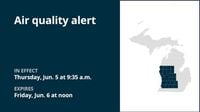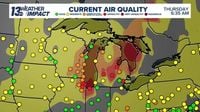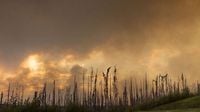Michigan is grappling with hazardous air quality as smoke from widespread Canadian wildfires continues to drift south, blanketing large portions of the state in unhealthy air. The Michigan Department of Environment, Great Lakes and Energy (EGLE) has issued ongoing air quality advisories and alerts, affecting nearly all Lower Peninsula counties and parts of the Upper Peninsula through Friday noon, June 6, 2025.
The source of the smoke is a series of intense wildfires burning across three Canadian provinces—Ontario, Manitoba, and Alberta—as well as Saskatchewan. These fires have forced roughly 27,000 Canadians to evacuate their homes, and their smoke has traveled thousands of miles, even reaching Europe. The jet stream’s current pattern is funneling the smoke into the upper Midwest, with Michigan bearing the brunt of its impact.
Detroit, for instance, was ranked the fifth most polluted major city worldwide as of 5:30 p.m. on Thursday, June 5, with an Air Quality Index (AQI) reading of 159, which is classified as unhealthy. Other cities across Michigan, including Lansing and Grand Rapids, are also experiencing poor air quality. Lansing’s AQI reached a concerning 183 on the morning of June 5, signaling unhealthy conditions prompting officials to urge residents, especially those with respiratory or heart conditions, to remain indoors.
The nature of the threat lies in the fine particulate matter known as PM2.5—particles 2.5 micrometers or smaller, about 30 times thinner than a human hair. These particles can penetrate deep into the lungs and even enter the bloodstream, posing serious health risks. Aaron Ferguson, manager of the Climate and Tracking Unit at the Michigan Department of Health and Human Services (MDHHS), explained, “It’s so fine, it’s narrower than the diameter of a human hair, can get deep into people’s lungs and even into the bloodstream which can cause issues.”
Sensitive groups—such as children, older adults, pregnant people, and those with heart or lung diseases like asthma or chronic obstructive pulmonary disease (COPD)—are particularly vulnerable. Dr. Natasha Bagdasarian, chief medical executive with MDHHS, described the situation as “dynamic” and urged residents to monitor local air quality continuously. “It's really important for people to get an app or a website that they know and trust and to use it regularly,” she said, emphasizing that air quality can change rapidly and recommendations may shift accordingly.
Medical experts warn that symptoms from exposure to wildfire smoke can include wheezing, coughing, chest tightness, dizziness, and burning sensations in the nose, throat, and eyes. The American Lung Association has advised sensitive individuals to stay indoors and avoid strenuous outdoor activities. The general public is also cautioned to reduce outdoor exertion and limit exposure.
In practical terms, residents are encouraged to keep windows and doors closed, especially overnight, to prevent smoke from infiltrating homes. Running central air conditioning systems with MERV-13 or higher-rated filters is recommended to improve indoor air quality. For those without air conditioning or in need of cooler spaces, local cooling centers or shelters may be available, with information accessible by calling or texting 211.
Outdoor activities such as burning debris, using wood-burning devices, gasoline-powered lawn equipment, or topping off fuel tanks should be avoided to prevent adding to the pollution burden. The National Weather Service and the Southeast Michigan Council of Governments (SEMCOG) have issued advisories urging residents to limit these activities.
Face coverings are another important consideration. While ordinary surgical or cloth masks do not filter out the fine PM2.5 particles, N95-style respirators can provide effective protection for those who must be outdoors. However, staying indoors remains the best defense against smoke exposure.
The smoke has also caused noticeable impacts beyond health. Visibility in many areas has been reduced, and residents have reported a persistent campfire-like smell in the air. For example, a 10-year-old boy named Alex Andres in Muskegon described seeing “black fog” and smelling gas and house fires. His family cut short a beach outing after his 1-year-old cousin felt unwell, a decision many are making as awareness of the smoke’s dangers grows.
Despite the discomfort and health risks, some residents remain less alarmed. Larry Smith, who was playing fetch with his dog near Muskegon, noted that the smoke was “a lot thicker last year” and that while he was prepared to go indoors if symptoms appeared, he felt okay at the moment.
The National Weather Service forecasts that the frontal boundary responsible for pushing the smoke into Michigan will clear the state by Saturday morning, shifting winds to the north and northeast. This should push the smoke south and west, improving air quality by the weekend. However, lingering smoke is expected to keep particulate levels in the moderate range for some areas through Saturday, especially in southern Michigan.
Residents are advised to monitor real-time air quality indexes via resources such as the MiAir Quality Index Dashboard, AirNow.gov, and trusted weather apps. Staying informed can guide decisions about outdoor activities and protective measures.
Animal health is also a concern. State Veterinarian Nora Wineland cautioned that pets and wildlife, particularly birds and those with pre-existing respiratory or heart conditions, can suffer from poor air quality. Signs of distress include coughing, wheezing, lethargy, and decreased appetite, and owners are advised to keep animals indoors as much as possible.
In sum, the Canadian wildfires are not just a distant crisis; their smoke is affecting the daily lives and health of Michiganders across the state. The combination of official advisories, expert recommendations, and community responses underscores the importance of vigilance and precaution in the face of this environmental challenge.






